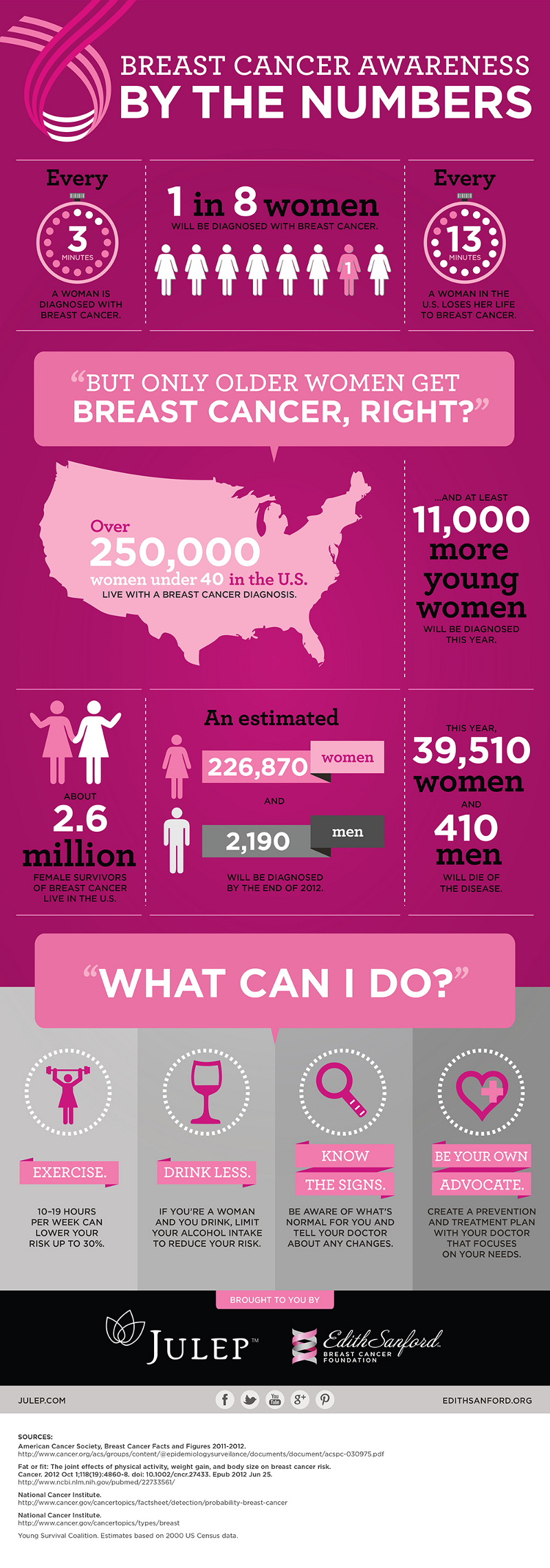Breast cancer can strike men and women at any time. It is one of the most common cancers that affects people in the world today and it is especially prevalent in the United States.
About 1 in 8 women in the United States will develop invasive breast cancer at some point in their lifetime.
Nearly 250,000 new cases of invasive breast cancer are expected to be diagnosed in the next 12 months. Another 60,000 new cases of non-invasive breast cancer will be added to those numbers. About 2,300 men will also be diagnosed with this disease. Knowing the demographics of breast cancer can help each of us reduce our risks in some way.
Why We Need to Know About Breast Cancer
- Breast cancer death rates in the US are higher than any other cancer, with the exception of lung cancer.
- Outside of skin cancer, breast cancer is the most commonly diagnosed cancer in US women. About 30% of new cancers in women will be breast cancers.
- White/Caucasian women are slightly more likely to develop breast cancer than African-American/Black women, but the roles are reversed for women under the age of 45.
- The risks of developing and dying from breast cancer is lower in Asian, Hispanic, and Native-American women.
- In 2015, there are more than 2.8 million women with a history of breast cancer in the U.S.
- Fewer than 15% of women who get breast cancer will also have a family member diagnosed with the disease.
- Up to 10% of breast cancers can be attributed to genetic mutations of the BRCA1 or BRCA2 genes.
There are two significant risk factors for breast cancer development: age and gender. Older women have the greatest risk of cancer development. This only increases if there is a detected BRCA1 or BRCA2 mutation. Women with a BRCA1 mutation have up to a 65% lifetime risk of developing breast cancer. With a BRCA2 mutation, women face a 45% risk. Women with these mutations also tend to develop cancer at a younger age. In men, it is the BRCA2 mutation that causes the most risk, with a 6.8% lifetime risk factor. Without the mutation, a man’s risk is just 1 in 1,000 for breast cancer.
Why Breast Cancer Is A Developed Nation Issue
- Women who live in developed countries also tend to have a higher lifetime risk of breast cancer than women who live in developing countries.
- African-American women have the highest breast cancer mortality overall, while Asian-American and Pacific Islander women have the lowest.
- Immigrants in the U.S. usually have breast cancer incidence (new cases) rates similar to those in their home country. In 1-2 generations, however, the risk factors match those of US rates.
- Women with an Ashkenazi Jewish descent have higher overall rates of breast cancer prevalence because of high rates of gene mutations.
Why are developing nations at a lower risk than developed nations for breast cancer? It could be that the risks are the same, but there are fewer qualified physicians available to diagnose the issue. Developing nations tend to have different lifestyle habits in regards to nutrition and reproduction habits, which may also alter how this disease develops. The bottom line is this: it only takes a generation or two for the risks to adapt to the developed world and US women face the highest risks of all. This cannot be ignored.
Breast Cancer and The LGBTQI Community
- Lesbians and bisexual women have a greater risk of breast cancer than other women because of lifestyle risk factors, such as not having children, rather than sexual orientation.
- Lesbians also tend to have higher rates of alcohol use and obesity, which are also breast cancer risk factors.
- Data on transgender men and women with breast cancer is extremely limited, so it is important to receive an individualized risk assessment.
- Lesbians and bisexual women may have less access to health care, which may cause fewer screenings and mammograms to take place.
- Most breast cancers and breast cancer deaths occur in women aged 50 and older regardless of sexual orientation.
- Less than 5% of breast cancers occur in women younger than 40.
Breast cancer is a scary diagnosis. Unfortunately it is one that many women will face at some point in their lives, especially as they grow older. This is why it is so important to receive regular screenings, mammograms, and other tests so that if this disease does develop, it can be caught early and treated effectively.

Although millions of people visit Brandon's blog each month, his path to success was not easy. Go here to read his incredible story, "From Disabled and $500k in Debt to a Pro Blogger with 5 Million Monthly Visitors." If you want to send Brandon a quick message, then visit his contact page here.
